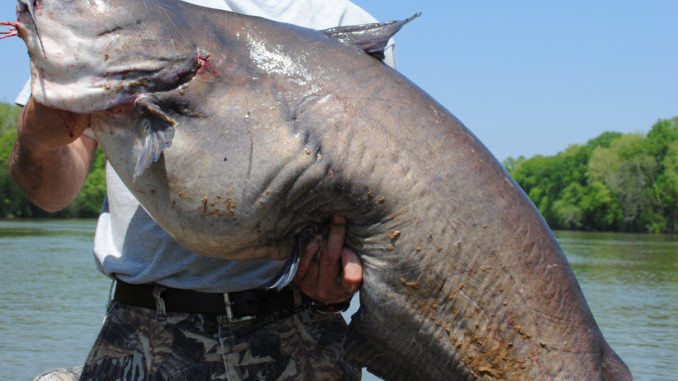
Guide says river may be holding world record
Until last Thursday, when I heard the phrase “cast-and-blast”, I thought about a morning turkey hunt along the Roanoke River and an afternoon fishing trip on the river for striped bass.
Spring turkey season and the spring spawning run for stripers coincide every year, and it’s a marriage made in heaven: the two best counties in North Carolina in terms of the number of turkeys killed annually (Northampton and Halifax), and the best riverine striper run in the Southeast.
Until last Thursday.
There wasn’t much of a “blast” during a morning turkey hunt at the Buchanan Shoals Sportsman’s Preserve in Anson County, but the afternoon cast was a blast that will be difficult to forget.
The turkeys just didn’t gobble great on a foggy spring morning, but guide Heath Rayfield, who manages the 5,300-acre preserve, did coax one longbeard into range for a visiting hunter who, inexplicably, missed at 25 yards.
No, it wasn’t me.
The afternoon fishing trip on Pee Dee River was one to remember.
Blue catfish were getting ready to spawn in the river – the preserve has seven miles of frontage on both the Anson and Rockingham County banks – and Rayfield said that any trip for the big cats could be a memorable one.
“You could very well sit out here and catch the world-record today – they’re in here,” said Rayfield (704-695-5007). “The biggest blue to come out of the river weighed 83 pounds, and the biggest flathead weighed 74. Last year, I hooked one that I never stopped.”
Rayfield cut steaks out of a huge gizzard shad for bait. He said he normally used filets from shad, but the baitfish he’d netted in the tailrace below Blewett Falls Dam a few miles upstream were on the small side – small, if you consider around 16 inches long and an easy pound-and-a-half small.
He put out six rods, three on either side of the boat in rod-holders mounted on the gunwales. They were medium-heavy catfish rods with big level-wind reels. The terminal rigs included 8/0 Gamakatsu circle hooks, a leader of about three feet, a barrel swivel, a plastic bead and a 2-ounce bank sinker to hold the bait on the bottom in the current.
“This time of year, the fish are not super deep,” said Rayfield, who positioned his G3 aluminum boat upstream from a dropoff. “There’s a little rock flat here in about eight feet of water, then it comes up to three or four feet, then drops back down.
“The blues are about to start spawning, but you can come out here anytime of the year and catch them. The flatheads will start to bite in May, but June and July are better months.”
It took 30 minutes before the first bite, but despite nearly jerking the rod out of the holder, the fish didn’t hook up. After another half hour, with small channel cats bothering the baits – that were too big for them to inhale – the rod on the starboard side of the bow suddenly rocked, and its tip bent toward the water.
“Get it and hold on!” Rayfield said.
He was talking to me.
I obeyed. Something on the other end of the line akin to a freight train took off. When I stopped its initial run, a big blue catfish boiled to the surface, spinning to try and get rid off the hook.
“That looks like about a 35-pounder,” Rayfield said.
Ten minutes later, when the rod, the reel’s drag, the current and a little effort on my part wore the fish down, it swam next to the boat and I lifted it to the surface. The sinker broke the water first, and a foot or so later, we got our first real glimpse of the fish.
Thirty-five pounds was a gross understatement. Rayfield made one swipe with the net – How big could that net have been? – and corralled a huge blue, its stomach bulging like it had swallowed a volleyball, with thick sides, a brutish head and a powerful tail.
The fish was better than 40 inches long, and a scale produced by Rog Rogers, one of the preserve’s other turkey guides, showed the fish as a 45-pounder.
“You see why I don’t go to Santee Cooper anymore?” Rayfield exulted. “That’s three hours away, and they don’t have anything down there we don’t have in this river.”
Straining to get the fish off the floor of the boat for pictures, I was asked, “Is that your biggest catfish?”
“Yes,” I replied, “by 25 pounds.”
Twenty-five pounds was the weight of the next blue that came aboard, an hour later, giving Rogers a start meat for a fish fry he’d promised his father.
Seventy pounds of catfish in two hours? The turkey season is a month-long. Surely there’s time out of the woods for another catfishing trip. Next stop: a 50-pounder.





Be the first to comment